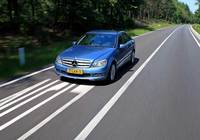2011 Mercedes-Benz C 180 CGI BlueEfficiency Review - First Drive
SEE ALSO: Mercedes-Benz Buyers Guide; 1997-2011
By Henny Hemmes
Senior European Editor
Amsterdam Butreau
The Auto Channel
 |
Still, it lasted some sixty years until Mercedes-Benz introduced its so-called CGI gasoline engines. CGI stands for Stratified-Charged Gasoline Injection, a technology that uses sophisticated petrol direct-injection with a spray guided combustion process. The efficient and clean engine has four catalyzers. It is powerful and fuel consumption is decreased compared to conventional port injection. The technology debuted in 2002 in the Mercedes CLK 200 CGI.
Compared to conventional port injection, direct fuel injection allows higher compression and consequently improved thermodynamic efficiency.
Until this summer, the second generation CGI engines that got the addition BlueEfficiency, were only available in combination with an automatic transmission, but now Mercedes also offers the CGI-engines in the C-Class combined with a 6-speed gearbox. Those variants get the Eco start/stop function, which stops the engine automatically when the driver has touched the brake pedal, put the gear lever into neutral and when the car’s speed drops below 8 km/h (5 mph).The engine starts egain as soon as the accelerator or clutch pedal is pressed.
 |
More vivid
With the arrival of the new C-Class, there were several improvements over the preceding generation. I like the crisp looks with the big Mercedes star in the grille. It marks the Avant-garde trim (Sport in the U.S.), while the base model gets the star on the hood. An important step forward is that the quite impassive and uninspiring steering feel has been replaced with one that is more precise reacting and provides a more involved attitude.
 |
Even though the car has not the same feel as a BMW 3-Series, it is much more than good enough for normal drivers. The suspension set up is not absolutely firm and if you want that, there is the Sport suspension option, with lower and firmer suspension and 17-inch wheels. But in standard trim it is firm enough for good handling. On bad road surfaces the shock absorbers quickly compensate and offer comfort for the car’s occupants.
The CGI engine in the test car was teamed to the five-speed automatic transmission, ideal in a car like the C, that in western Europe most people use intensively for business trips and consequently often hit traffic jams. It can be shifted sequential though, meaning that you move the lever from left to right to chose gears, but the transmission will intervene when the engine revs will get too high. The transmissions is a smooth shifter, but at lower revs it is reacting less alert to throttle input than from say, 2,300 rpm.
The new engine definitely is more vividly responding than the 180K. Its maximum power is available at lower revs, while the K motor needed higher revs for a sporty behaviour. The broad power band for the CGI’s torque lies between 1,600 and 4,200 rpm. The C180 accelerates from zero to 62 mph in just 9 seconds. While acceleration from 50-75 mph takes just over 6 seconds, it is fast enough to be able to safely overtake slower cars on two lane roads. The top speed of 140 mph is far above the speed limits in most countries, except for Germany.
Convenient is also the lower engine noise. The Kompressor’s sound was more penetrating, screaming, that of the CGI’s turbo remains much more in the background. Although there will always be people who like that sound of a turbo charger…
Business edition
 |
 |
The drivers’ position can be easily and optimal adjusted, the dashboard is well laid out and all buttons and other operational gear is within short reach. The materials in the cockpit, including real aluminium details, look nice. But that is it, there is nothing special.
The safety equipment includes a knee airbag for the driver and ESP, ASR and brake assist as well as a tyre pressure monitor and an indicator for brake pad wear. In Europe the C-Class earned a 5 star rating in the EurNCAP crash tests last year, while the Insurance Institute for Highway Safety IIHS named it one of the Top Safety Picks for 2009.
Mercedes has really improved the standard equipment of its models, but, as usual, the packages, and/or options may add serious money to the base price.
The availability of the C180 CGI engine not only for models with automatic but also for ones with a 6-speed gearbox means that the C180 Kompressor has been removed from the price lists in Europe and other markets worldwide. However, the C180 CGI and the 184 hp strong C200 CGI are not available in North-America (yet). This market only has the C350 CGI, but since downsizing is the trend, it is not unlikely that Mercedes will decide to introduce the fuel efficient variants here in the not too far future.
I am sure Americans will like them too.



